| Kongernes Nordsjælland
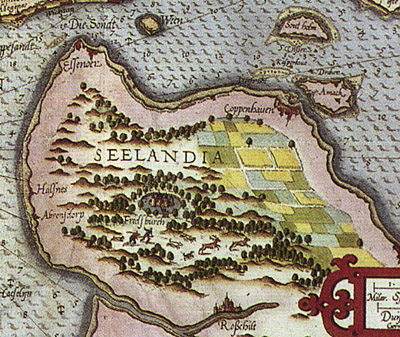
| | I starten af 1700-tallet ejede den danske kongemagt det meste af Nordsjælland, som fortrinsvis blev benyttet til jagtterræn og hesteopdræt.
I det naturskønne område blev der opført lystslotte med tilgrænsende haver i tidens barokstil.
|
Jagt
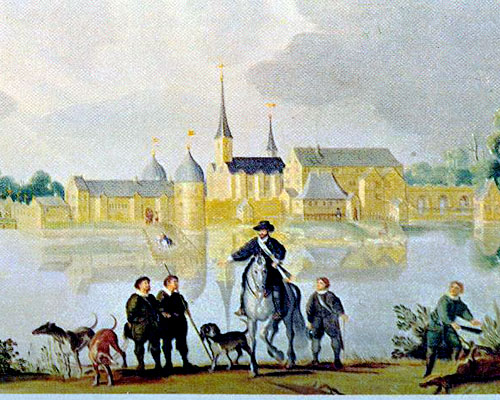
| | I starten af 1700-tallet ejer kongen det meste af Nordsjælland, som fortrinsvis benyttes til jagtterræn og hesteopdræt. |
Kongens domæne
Efter reformationen i 1536 overtager kongemagten omfattende jordbesiddelser fra klostrene i Nordsjælland og i tiden herefter øges kronens jordejendom i området yderligere. Omkring 1546 køber kongen således 64 selvejerbønder ud og ved jordbytte med adelen lykkes det i anden halvdel af 1500-tallet kongemagten at skabe rådighed over det meste af Nordøstsjælland.
Kongens hovedinteresse i Nordsjælland var jagten, og størstedelen af landskabet benyttes som jagtterræn og græsningsarealer for kongens heste. Det dyrkede areal var derfor sparsomt og kronbøndernes hoveriarbejde bestod hovedsagelig i høslet, træfældning og ikke at forglemme bygge- og anlægsopgaver. I Frederik II.s tid opføres således Kronborg og Frederiksborg Slot og i 1584 anlægges den første såkaldte kongevej som forbandt de to slotte.

Nordsjælland | 
Kongens jord | 
Det første Frederiksborg | 
Kongevej i Nyrup Hegn | 
Kongeveje i Nordsjælland |
Vildtbaner og dyrehaver
I Frederikd.2.s tid påbegyndes arbejde med at indrette vildtbaner og afspærrede dyrehaver, f.eks. Lille Dyrehave, der omgav selve Frederiksborg Slot. Christian 4., der i sin tid ombygger Frederiksborg Slot, fortsætter arbejdet med at forbedre jagtterrænet med anlæggelsen af Store Dyrehave syd for Hillerød, som indhegnes med røde stakitter. Han udbygger ligeledes kongevejene sydover, så han kan komme hurtigt frem og tilbage imellem Frederiksborg og den voksende residensstad København.
Christian d. 5.(1670-1699)havde som kronprins i 1662-63 gæstet den franske solkonge Ludvig d.14.s hof og her stiftet bekendtskab med parforcejagten og ønskede nu at skabe betingelser for at bedrive denne jagtform i Nordsjælland. 1669 påbegyndes anlægget af den senere Jægersborg Dyrehave, som i 1670 udvides af Christian 5. til også at omfatte det nuværende Jægersborg Hegn. En engelsk parforce-jæger, Robert Badge, indkaldes og allerede i efteråret 1670 drives parforcejagt med engelske hunde, heste og jægere.

Lille Dyrehave | 
Store Dyrehave | 
Frederiksborg 1652 |
Jægersborg og Frederiksborg
I 1680, efter afslutningen af Skånske Krig, påbegynder kong Christian 5. en samlet reorganisering af jagtterrænet. Han indkalder to eksperter fra England og fra omkring år 1700 foreligger der planer over de allerede påbegyndte anlæg omkring Frederiksborg Slot og den sydlige del af Esrum sø. Jægerborg bliver, som navnet antyder, centrum for administration af jagten, men selve jagten foregår i hele Nordøstsjælland. Kongen bedrev alle mulige andre former for jagt, oprettede et falkoneri og arrangerede dyrekampe. I Lille Dyrehave ved Frederiksborg var der således løver, elefanter og rensdyr og i slottets værelser fugle og aber sammen med yndlingshundene.
Ofte tog jagten udgangspunkt fra Frederiksborg Slot, men der var også en jægergård i Nyrup udenfor Helsingør og kongen holdt også til på Østrup, hvor Fredensborg nu ligger. Jagten var som oftest et omfattende foretagende, som krævede store ressourcer. Til en klapjagt på Jægerspris i 1680 skulle 500 mand møde som klappere og medbringe kost til 5-6 dage.
Parforcejagten
Parforcejagt foregik til hest, hvor jægerne ad de anlagte stier jagtede et stykke vildt med hunde, som sluttelig stillede vildtet, så kongen eller en af ham udpeget kunne få fornøjelsen af at aflive dyret med kniv (hirschfänger). Ømosen i nærheden af Gurre var et fast tilholdssted for de store hjorte og ofte udvalgte kongen her det pågældende dyr. 1720 var der 140 hunde og 50 hvalpe knyttet til parforcejagten. Jagthundene skulle indøves og det forgik på Jægergården i Nyrup.
Jagten varede som oftest flere timer og havde karakter af selskabelig begivenhed, hvor damerne fra åbne vogne, eller pavilloner kunne iagttage skuespillet med den enevældige monark som hovedrolleindehaver. Den englelske iagttager Robert Molesworth har beskrevet afslutningen på en jagt i Christian 5.s tid.

Parforcejagt | 
Parforcejagt | 
Parforcejagt |
Hoffets vildtforbrug
Normalt gik alt vildtet fra de kongelige jagtrevirer til den kongelige husholdning og hoffets vildtforbrug var stort. I 1680 anvendtes 56 retter vildt om ugen.Stutteri
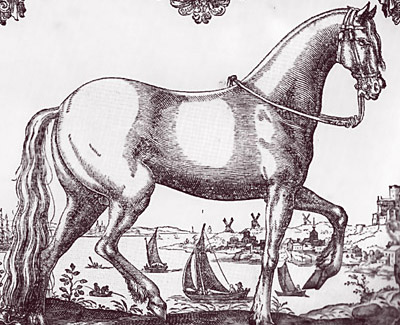
| | Frederiksborghesten regnedes i samtiden for en af i alt seks forædlede europæiske hesteracer. Med tiden avledes ensartet farvede heste i undergrupper, således at kongen kunne anvende typisk et seksspand af ensartede heste for en vogn, eller forære det som gave til andre kongelige. Frederiksborghesten på dette stik befinder sig pudsigt nok på Skånekysten med Kronborg i baggrunden. |
Frederiksborgstutteriet
Allerede fra tidlig middelalder er der vidnesbyrd om hesteopdræt- og eksport fra det danske område. Abbed Wilhelm af Æbelholt modtager således et takkebrev for en pragtfuld hest han har skænket abbed Stephan i Paris. En anden kilde fra omkring 1200 omtaler årlig eksport fra Ribe alene på 8000 heste og krønikeskriveren Arnold fra Lübeck beretter at landets rigdomskilde er hesteavlen.
Igennem hele middelalderen har hesten været uundværlig som kommunikationsmiddel: til transport, som arbejdsredskab og i krig. Behovet for og forbruget af heste har været enormt og ridderen til hest bliver nærmest et ikon på middelalderen. I dansk sammenhæng er der kendskab til at kong Erik Menved, ved en fyrstefest udenfor Rostock i 1311, forærer mere end 80 mænd ”en pasgænger til hver”, altså hver en hest, med tilbehør og klædning i forbindelse med at de slås til riddere.
Koncentration i Nordsjælland
Hesteopdræt i middelalderen, hvor kongen varetog sine administrative pligter ved rundrejser i riget, har fundet sted på adskillige af de kongelige ejendomme,, men også på adelens og klostrenes jorder. Med reformationen i 1536 overtager kongemagten klosterjorden og ved at bytte jord med adelen samler kronen efterhånden det meste af jordejendommen i Nordøstsjælland. Hensigten er bl.a. at skabe sammenhængende jagtarealer og at fremme hesteavlen.
I Christian 3.s tid opkøbes frisiske heste til stutterivange ved Esrum Sø og Frederik 2.interesserer sig allerede ved sin tronbestigelse i 1559 for hesteavlen. I 1560 forlader de sidste munke Esrum Kloster og kongen indforskriver samme år heste fra Nyborg Slot til Frederiksborg, hvor der i 1562 oprettes stutteriet. Fra d.5.april 1584 stammer følgende kongelige befaling:
”Kongen har truffet foranstaltning til at folene på Faurholm kunne blive hentede derfra; den grå tyrkiske hest, som kongen har fået af kongen af Polen, skal han lade komme til det ungerske stod på Fauerholm.”

Frederik 2. hyldes 1559 | 
Ridderturnering | 
Slottet Sparepenge | 
Esrum Kloster | 
Det første Frederiksborg |
Renæssancens heste
Ejendommen Fauerholm havde Frederik d. 2. byttet med adelsmanden Peder Oxe som i stedet fik Tølløse på Midtsjælland. Af et brev fra den efterfølgende dag fremgår det endvidere at der også var hestestod ved både Esrum og Hørsholm og at disse bl.a. rummede kraftige heste af frisisk karakter. Disse heste anvendtes fortrinsvis som køreheste. Tilsyneladende var kongen i besiddelse af både tyrkiske(arabiske) og ungarske heste og han importerede også heste fra Italien og Spanien for at udvikle avlen.
Tiden stiller nye krav til hestenes udseende og anvendelse, både militært og civilt. Kongemagten bliver mere bofast og hestene anvendes nu i stigende grad i repræsentative sammenhænge. Allerede i Frederik 2.s tid bliver den danske hest berømt ude omkring i Europa. Den ærkekatolske spanske regent Philip d.2. bestiller således i 1583 60 hopper med henblik på avl og den franske konge rekvirerer et lignende antal. Man må forestille sig prototypen som en robust og alsidig hest, som egner sig som både ride- og kørehest.

Fauerholm |
Christian 4.s tid
Christian 4. ombygger det første Frederiksborg og ved lystslottet Sparepenge opføres i 1599 en stald til 300 heste. Der indføres brændemærkning af hestene og i 1610 bliver Esrum, som hovedsagelig var en græsgård, hovedsæde for stutteriet. Et tilsvarende anlæg planlægges ved Börringe Kloster i Skåne.
I sammenhæng denne omlægning nedlægges en række landsbyer langs Esrum Sø, jorden udlægges til stutterivange(kobler) og der opføres og udbedres diger og grøfter. Der var desuden to stod ved selve Frederiksborg, hvor også tilridningen af hestene foregik. Den danske hest, Der Dänen Ross, beskrives i 1610 som en af seks forædlede europæiske hesteracer. Fortsat en robust hest med barokhestens betydelige tyngde, som det bl.a. fremgår af rytterportrætter af Christian 4.

Frederiksborghesten | 
Christian 4. til hest | 
Frederiksborg 1652 | 
Rideskolen |
Krigens betydning.
Svenskekrigene med besættelse og plyndringer i tiden 1657-1660 gik hårdt ud over stutteriet. En del heste tog svenskerne som krigsbytte, andre løb forvildede rundt i skovene og det var vanskeligt at få overblik over situationen. Det hedder herom i en skrivelse fra 1661.
”Udi Kronborg Len er ingen Ladegård uden Esrom, hvorpaa holdes kongl. Majestæts Stutteri. Ellers ligger her under Slottet trende Engvange, Gurre Vang, Teglstrup Vang og Egebæks Vang”
Kronborg Amt udgjorde den nordlige del af det nuværende Frederiksborg Amt, Frederiksborg Amt den sydlige del. Esrum er altså fortsæt centrum for Stutteriet, mens de nævnte engvange fortrinsvis anvendes til høslet. Efter høhøsten lod man som oftest hopper med føl afgræsse engene.

Hestehavehus |
Enevælde og barokheste
Christian 5.(1670-1699) havde som kronprins besøgt Ludvig d.14.s hof og der studeret enevældens pragtudfoldelse på nærmeste hold. Allerede i 1670 tager han initiativ til indførelse af tidens jagtmode, parforcejagten, indkalder dertil engelske rådgivere og indfører engelske heste til brug herfor.
I løbet af nogle årtier er stutteriet tilsyneladende kommet på fode igen efter svenskekrigene. Herom vidner bl.a. den medgift som kong Christian 5. giver sin søster, Ulrikke Eleonora, da hun i 1679, efter Skånske Krigs ophør, skal giftes med den svenske kong Carl d.11. Prinsessen forsynes med ikke mindre end 7 forspand med 6-7 heste i ensartede farver, og så det løse.

Dressurridning | 
Christian 5 | 
Rød ridedragt | 
Ridedragt 2 | 
Ridedragt 3 |
Et væddeløb
Om hestenes anvendelse og færdigheder fortæller også et berømt væddemål imellem den engelske gesandt Robert Molesworth og kongens overstaldmester, Anton Wolff baron von Haxthausen. De to vædder 1000 hollandske dukater, en ganske betydelig sum, om, hvorvidt en af kongens heste kunne løbe distancen fra Nørreport i København til byporten i Hillerød, i alt 35 kilometer på under 45 minutter.
Molesworth fik lov at vælge frit imellem fem rideheste i den kongelige stald og valgte en lille tigret(plettet) hest, som 14 dage senere gennemførte ridtet på 42 minutter, altså under den fastsatte tid. Der var her tale om en såkaldt Coureur(løber), som måske anvendtes specielt til parforcejagten Ifølge overleveringen findes den pågældende hest udstoppet på Christiansborg Ridebanemuseum

Robert Molesworth | 
Udstoppet hest |
Rideopvisninger
Hestevæddeløb var ikke en almindelig foreteelse på dette tidspunkt. Offentlig optræden var begrænset til repræsentative sammenhænge, f.eks. bryllup og begravelser, men for hoffet og indbudte gæster var der også indendørs optræden i f.eks. Christiansborg Ridehal. Ridebanen udenfor kunne naturligvis også benyttes og rundt omkring i København fandtes andre egnede arealer. Christian 5. foretræk efter sigende et areal i Rosenborg Have, men f.eks. var Kongens Bytorv, hvor Christian 5.s rytterstatue nu står, oprindelig planlagt som ridebane.
Ved de store hoffester optrådte kongen selv med andre i turneringer med ringridning og fingerede bataljer med kostbare præmier til vinderne. En øjenvidneskildring af festligheden ved Ulrikke Eleonoras forstående bryllup i 1680 beretter udførligt om en sådan optræden på Christiansborg Rideplads d. 11.april. Efter optræden med ringridning og hesteballet afsluttes med en tredje halvleg med dyrekampe imellem hunde og bjørne, tigre, grævlinger og tyre.

Prins Jørgen i trav | 
Prins Jørgen på Pompeux | 
Hesteballet | 
Rosenborgtapetet | 
Det oprindelige Christiansborg |
Den Høje Skole
Christian 5. var selv var en fortrinlig rytter, der efter sigende kunne ride 6 heste trætte på en formiddag. Det handler i den daglige træning om dressur, forskellige gangarter og spring, efter den såkaldte Høje Skoles principper. Alle disse gangarter og spring er udførligt skildret på en række malerier fra 1690erne, udført af en ukendt kunstner op ophæng på Rosenborg Slot.
Her kan man iagttage de forskellige gangarter, volter og spring, som egentlig stammer fra krigskunstens brug af hesten. Halvdelen af de 24 malerier skildrer dette, mens den anden halvdel viser scener af de såkaldte ridekarousseller optræden med ringridning med videre. De afbildede heste har, som den nuværende lippizanerhest, typisk barokhestens kendetegn,: Krumnæset hoved, svær, tykstrubet hals, lang ryg og muskuløst kryds. Billederne er efter tidens mode noget fortegnede, men viser også nogle af kendetegnene for den senere Frederiksborghest.

Dressurridning | 
Prins Jørgen i trav | 
Prins Jørgen på Pompeux | 
Krindsen | 
Ringridningsgitter |
Renavlen
I 1690 udsendes en stutteriordning, hvorved der indføres nye principper med såkaldt renavl efter farve, dvs. man oparbejdede enheder (stod) med ensartede heste, røde, hvide heste osv., således at kongen kunne råde over adskillige forskelligartede spand til sine mange officielle gøremål. Renavl efter farve betegner et skift i moden som har været undervejs i flere årtier, men som nu også bliver toneangivende i rokokotidens smag og retningsgivende for avlen ind i 1700-tallet.
Der indkøbes et stort antal især spanske hingste for at fremme bestræbelsen på renavl og i første omgang med gode resultater.

Heste foran Christiansstad | 
Mangefarvede heste | 
Bella og Hertha | 
Hingsten Hother |
Ryttergods og stutterier
Omkring 1700 indføres en ordning med såkaldt ryttergods, hvor en kavalerist forsynes med et lille jordlod og en hest han skulle stille med i krigstid. Krongods udlægges til formålet og kongens stutterivirksomhed leverer hestene. I 1717 overgår Esrum Kloster til ryttergods og en stor del af jorden udlægges hertil. Samme år flyttes centrum for avlsarbejdet tilbage til Frederiksborg Slot og i 1720 gøres Lille Ladegård ved Frederiksborg Slot til nyt centrum for stutteriet.
Et kort fra omkring 1720 viser stutterivangenes beliggenhed i sammenhæng med ryttergodset. Det viser et udstrakt foretagende med centrum omkring Grib Skov og Esrum Sø. Arealerne, vangene, var spredt udover hele Nordsjælland, fra Egebæksvang i øst til Pandehave Hestehave i nord. Mange stednavne i Nordsjælland, f.eks. og Hestehave ved Hillerød, Søborg Hestehave, og en lang række lokaliteter i Grib Skov med endelsen –vang, vidner fortsat om stutteriets aktiviteter.

Stutterivange 1720 | 
Stutteriet ved Frederiksborg | 
Græssende heste |
Stutteriets storhedstid
Første del af 1700-tallet betegner Frederiksborgstutteriets storhedstid og det bliver landets største landbrugsenhed med samlede tilliggender op på 11.300 tønder land, 100 fastansatte personaler og efterhånden op imod 1600 heste. Det bliver imidlertid også begyndelsen til enden. Princippet med renavl efter farver rummede stor risiko for indavl og dette bliver med tiden stadig mere tydeligt. Desuden var forbruget af heste enormt og det var forbundet med stor prestige for kongemagten at anvende de ensfarvede heste som gaver til andre kongelige.
Da Frederik 4.(1699-1730) i 1708 begiver sig på rejse ned i Europa medbringer han således to hvide hingstespænd fra Krogdalsvangen, som han forærer bort undervejs. Nogle år løb foræringernes antal op på 150 individer og medførte at man måtte opkøbe nye og andre heste til stutteriet. Da samme Frederik 4. i 1730 begraves anvendes ikke mindre end 120 helt sorte heste i forbindelse med ligtoget fra København til Roskilde.

Krogsdalsvang | 
Vangesten |
Fortsat udvidelse
Frem til omkring 1740 er hestene vinteropstaldet rundt omkring på de kongelige ladegårde, men i perioden 1742-46 opfører arkitekten Laurits de Thurah et samlet stutterikompleks kaldet Frederiksborg Ladegård. Omkring samme tidspunkt påbegynder billedhuggeren Saly en rytterstatue, der siden hen er berømmet som en af verdens bedste, og bliver selve symbolet på Frederiksborghesten. 22 år tog der Saly at færdiggøre statuen, der var skænket af Asiatisk Kompagni, som nærmest blev ruineret af projektet.
Et kort fra 1765 viser stutteriets udstrækning i Frederiksborg Amt. Her ser man stutteriets kerneområder bestående af en række vange omkring Esrum Søs vestbred, et lignende område selve Frederiksborg og endelig Store Dyrehave med tilliggende arealer. Fra dette tidspunkt stammer også en beretning om vangenes tilstand og anvendelse.

Frederiksborgstutteriet 1753 | 
Ladegården | 
Statuen på Amalienborg | 
Stutterivangene 1765. |
Nye toner
I de efterfølgende år kommer stutteriet i regulær krise, bl.a. på grund af indavl, og under Struenses regime 1771-73 begynder man at indskrænke virksomheden. Den engelskfødte dronning og Struenses elskerinde, Caroline Mathilde, er måske den sidste dronning der får hestehold i stor målestok til eget personlige brug: 2 rideheste og 31 køreheste.
Oplysningstidens nyttebetragtninger begynder nu at vinde indflydelse og for at rette op på økonomien beslutter man at sælge heste fra. Det sker på en auktion på Christiansborg og bliver et tilløbsstykke fra hele Europa. En af de frasolgte hvide hingste, Pluto, bliver en af stamfædrene til de berømte Lippizanerheste, en hoppe stammoder til den russiske Orloff-traver.
Bortsalget stopper imidlertid ikke tilbagegangen i avlen. Forsøg med avl på tværs af de enkelte stod fra omkring 1776 giver nogle positive resultater, mens eksperimenter med at hærde hestene, bl.a. ved udsætning af Fanestoddet fra Pibervangen på Hesselø i 1784, får katastrofale følger. I 1790 bliver det kongelige stutteri lagt sammen med landstutterivæsenet og skal nu i oplysningstidens ånd også medvirke til at ophjælpe bøndernes hestestammer. Et kort fra 1792 viser at stutterivangene på Cronborg Amt endnu på dette tidspunkt optager store dele af Grib Skov.

Stutterivange 1792 | 
Strøgårdsvang | 
Høsletseng |
Den store reduktion
Trods store vanskeligheder og omkostninger fremstår Frederiksborgshesten efterhånden som et nationalsymbol og først i 1799 indskrænkes stutterivirksomheden for alvor. I 1799 finder så den såkaldt store reduktion sted. 1170 tdr. land afgives til den nyoprettede avlsgård Fauerholm og de fem oprindelige stutterivange langs Esrum Sø overgår til Skoven. Skov- og landbrugsreformerne i slutningen af 1700-tallet har da allerede grebet dybt ind i stutteriets driftsform. Agerjorden er blevet udskiftet, noget heraf udstykket til husmandsbrug, men først i 1840 afløses de sidste rester af høsletshoveriet, bøndernes pligtarbejde for stutteriet.Fredensborg Slot
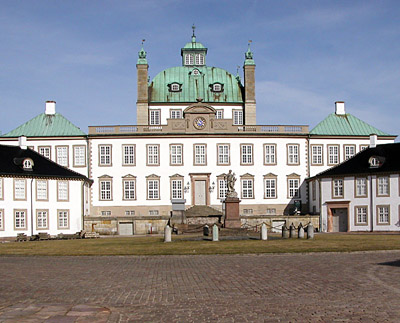
| | Efter afslutningen på Den store Nordiske Krig i 1720 synes man i Danmark endeligt at have opgivet tanken om at få Skånelandene tilbage. I hvert fald er fredstrangen så stor at kongen ved anlæggelse af en ny residensbolig mellem Frederiksborg og Kronborg vælger at kalde denne for Fredensborg og ifølge overleveringen var det de penge, der var afsat til krigen, som anvendtes til byggeriet. |
Europas stormagter dominerer
Ved fredslutningen efter Den store Nordiske krig i 1720 var de to dobbeltriger Danmark-Norge og Sverige-Finland vel stort set jævnbyrdige, men også reduceret til brikker i er internationalt spil, der var domineret af de europæiske stormagter Frankrig, England, Holland og efterhånden også Rusland og det tyske område (Preussen), hvor samlingsbestræbelser tager fart i løbet af 1700-tallet.
Fredensborg: Et fredssymbol
I Danmark synes man efter Den store nordiske Krig endelig at opgive tanken om at få Skånelandene tilbage igen. I hvert fald er fredstrangen så stor at kongen ved anlæggelse af en ny residensbolig mellem Frederiksborg og Kronborg vælger at kalde denne for Fredensborg og ifølge overleveringen var det de penge, der var afsat til krigen, som anvendtes til byggeriet.
Hvor Fredensborg Slot nu ligger lå tidligere en jagtejendom eller lystgård med navnet Østrupgård, hvor kong Frederik 4.. gerne tilbragte tiden i stedet for det prangende Frederiksborg Slot. I 1719, da man efterhånden kunne skimte afslutningen på Store nordiske Krig, lader kongen bygge en kalkovn, ryddede veje og skove som forberedelse til en nyopførelse på stedet. Allerede i 1722 står hovedbygningen færdig og nybygningen får navnet Fredensborg, hvilket henviser til fredslutningen efter den store krig. Oprindelig var det da også tanken at kuplens lanterne på hovedbygningen skulle have været en statue antagelig af fredsgudinden.

Fredensborg Slot | 
Set fra parken |
Barok med renssancepræg
Det oprindelige anlæg bestod af den anseelige hovedbygning med kuppelsal, som endvidere udgjorde den ene side i et ottekantet anlæg, som tillige med nogle fritliggende bygninger opføres under den senere landbygmester J. C. Krieger, som på daværende tidspunkt var gartner ved orangeriet i Rosenborg Have.
Forbilledet er måske den franske konges lystslot Marly, som kongen havde set på den første af sine udenlandsrejser i 1691-92. I det ydre har slottet imidlertid ikke meget til fælles med den overlæssede franske barokstil. Fredensborgs glatte murfacader genfindes på Frederiksberg Slot. Kun de brede vinduesindfatningerne med overliggende frontoner fungerer dekorativt, men de ligner mest af alt vinduesindfatningerne på Kronborg, som er i renæssancestil. Trods disse renæssanceindslag er hovedindtrykket dog iflg. "Slots- og Ejedomsstyrelsen", barok:
"Det smukke 1700-tals barokslot danner ofte rammen om større officielle statsbesøg og familiebegivenheder i kongefamilien."
Den tillempede renæssancestil er da også ganske særegen og har mest lighed med stilen på Stockholm Slot, der er opført af den berømte svenske arkitekt Nicodemus Tessin den yngre. Formodentlig er inspirationen gået via den senere landbygmester Johan Conrad Ernst, der i 1697 opholder sig hos Tessin i Stockholm for at sætte sig ind i konstruktionen af et residentsslot, som Christian d. 5. havde tænkt at opføre i Amalienborg Have i København. På denne måde er opførelsen af Fredensborg Slot et vidnesbyrd om den kulturelle udveksling imellem de to lande, som bestod på trods af krig og uenighed.

Det oprindelige udkast | 
Døre og vinduer |
Jardins indflydelse
Efter Fredensborgs opførelse i 1723 kommer snart alle betydelige arkitekter i århundredet i berøring med byggeriet i forbindelse med udvidelser og ændringer, som dog heldigvis ikke spolerer slottets oprindelige karakter. Sidst, men ikke mindst, er den franske arkitekt N.H. Jardin involveret i planer for en større ombygning af selve slottets hovedbygning og haven, som omlægges over en årrække fra 1759-68. Størstedelen af de øvrige projekter opgives da kongen omkring 1762 skal bruge flere penge på oprustning på grund af modsætningsforhold til Rusland.

Fredensborg 1729 | 
Jardins plan 1760 | 
Normandsdalen |
Barokhavernes tid
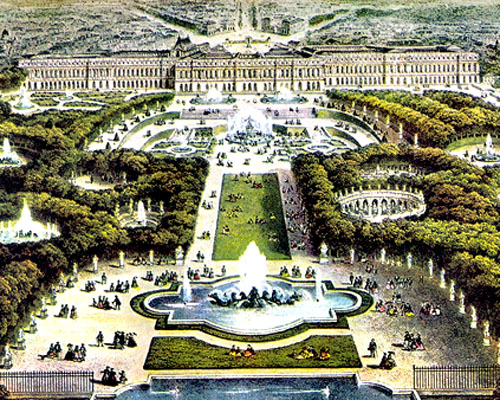
| | Europas enevældige konger blev i 1700-tallet inspireret af bl.a. Versailles i Frankrig og fik anlagt barokparker, der skulle markere magt og enevælde.
Eksempler på sådanne anlæg er Frederiksborg og Fredensborgs slotshaver samt Marienlyst i Helsingør. |
Frederik 4.s haver
Selve fredsslutningen efter Store nordiske Krig fandt sted på Frederiksborg Slot, hvor den danske konge, Frederik 4..(1699-1728), efter krigsafslutningen 1720 tog fat på at anlægge et omfattende haveanlæg med tilhørende vandkunst.
Ligesom sin far havde kong Frederik som kronprins i 1692-93 været på dannelsesrejse sydpå, gennem Tyskland til Italien og Frankrig, hvor han gæstede solkongen, Ludvig d.14.s hof. Mens Christian 5. hentede inspiration til fornyelse af jagt og hesteopdræt, var det der optog Frederik først og fremmest haveanlæg og gerne med indlagte springvand og kaskader. Dette havde han lejlighed til at iagttage bl.a. ved besøg i renæssancehaver i Norditalien og naturligvis også det imponerende barokanlæg ved Versailles-slottet udenfor Paris.

Versailles |
Frederiksborgs barokhave
Allerede i 1702 begyndte kongen at overveje at fjerne Sparepenge og den tilhørende have for at udnytte det skrå terræn på den anden side af slotssøen til anlæggelse af en større barokhave. 1720 begynder kongen at virkeliggøre sine planer. Sparepenge bliver brudt ned og en del af stenene herfra anvendes til opførelsen af Fredensborg Slot. I årene 1720-25 opføres den nye have efter plan af arkitekten Johan Cornelius Krieger.
Anlægget er på 100x 400 meter, anlagt i tre planer på det skrånende terræn. Venstre side af anlægget er koncentreret om en midterakse, der udgøres af en gennemgående vandkaskade. Anlægget omkring denne akse er symmetrisk beplantet, hvor de lave parterre-bede på første trin udgøres af varierede kongelige monogrammer.

Frederiksborg slotshave | 
Frederiksborg Slots omgivelser |
Havens ide
Anlæggets midterakse afsluttes med en obelisk der i samspil med den vertikale beplantning medvirker til at skabe et optisk bedrag, en fornemmelse af et næsten uendeligt anlæg. Hermed demonstrerer ophavsmanden sin evne til at beherske landskabet og naturen.
Endvidere forlænges den gennemgående akse naturligt over søen til selve slotsanlægget, den enevældige monarks bolig. Samlet er det et udtryk for monarkens kontrol over og beherskelse af natur og kultur i en samlet enhed. Beherskelsen kommer til udtryk ned i de mindste detaljer, gennem den velordnede symmetri og den sirlige klipning af beplantningen. Anlægget skal imponere beskueren og udtrykke den enevældige statsmagt formåen.
Fredensborg Slotshave
Fredensborgs Slots forgænger Østrup var en integreret del af kongens jagtanlæg, faktisk beliggende midt en af parforcejagtanlæggets stjerner, hvor en række anlagte vej mødtes. Dette blev også udgangspunkt for det haveanlæg, som arkitekt og bygmester Krieger tog fat på omkring 1722.
De af hensyn til jagten udhuggede veje i skovlandskabet blev nu omdannet til alleer, som samledes i centrum af hovedbygningens havestue. Tværgående veje blev tilføjet og inderst i denne halvcirkel blev anlagt en række parterre-bede i regelmæssige mønstre, formodentlig beplantet med takstræer, som var hentet fra Jægersborg. Mod vest anlagdes desuden en række firkantede parterre-bede, som bl.a. rummede kongelige monogrammer.
I tilknytning til anlægget skabtes såkaldte runde alleer, herunder den såkaldte Normandsdal, der opføres omkring 1760. Fra samme tidspunkt stammer en detaljeret plan for reorganisering af haven ved den franske arkitekt N.H. 191. I denne fremhæves en centralakse med udgangspunkt i den midterste alle, men de øvrige alleer bibeholdes og samlet dannes der et såkaldt gåsefodsmønster, som f.eks. også genfindes i Versailles-parkens barokke haveanlæg. Anlægget er således fortsat barokt i sin grundstruktur, men Normandsdalen med sandstensfigurer af norske og færøske godtfolk vidner om oplysningstidens interesse for kortlægning og registrering med udgangspunkt i Christian d.6.s Norgesrejse i 1733.

Fredensborg 1729 | 
Jardins plan 1760 | 
Normandsdalen | 
Nordmandsdalen |
Frederiksberg Have
Frederik 4.lod i starten af 1700-tallet også Frederiksberg Slot opføre i umiddelbar nærhed af residensbyen København. Formålet var bl.a. ar skabe et nærrekreativt område for hoffet og til dette hørte naturligvis også en have. Fra omkring 1760 stammer en plan som viser er typisk barokanlæg med et strengt symmetrisk anlæg både foran og bagved hovedbygningen i det nuværende Søndermarken på den anden side af Roskildevej.

Frederiksberg Slot | 
Frederiksberg Have |
Marienlyst Slot og barokhave
Den franske arkitekt Nicholas-Henri Jardin kom oprindelig til Danmark for at udbygge den såkaldte Frederiksstad i midten af København. Planerne herfor blev imidlertid aldrig til noget, men i stedet kom Jardin til at virke i forbindelse med Fredensborg nye haveanlæg omkring 1760 og arbejdede samtidig med en ombygning af det gamle lysthus Lundehave udenfor Helsingør. Jardin valgte at bibeholde det gamle Lundehave som et fremspringende midterparti i en tredelt bygning i klassicistisk stil.
Hermed fik Danmark et tidligt og vellykket bygningsværk i en ny tids stilart. Barokstilen er ved at tone ud, men det iagttages endnu i det tilhørende haveanlæg, der fortsat er strengt symmetrisk anlagt i den barokke, franske havestil.

Marienlyst Slot i Helsingør | 
Moltkes Haveanlæg | 
Marienlyst med have. |
|